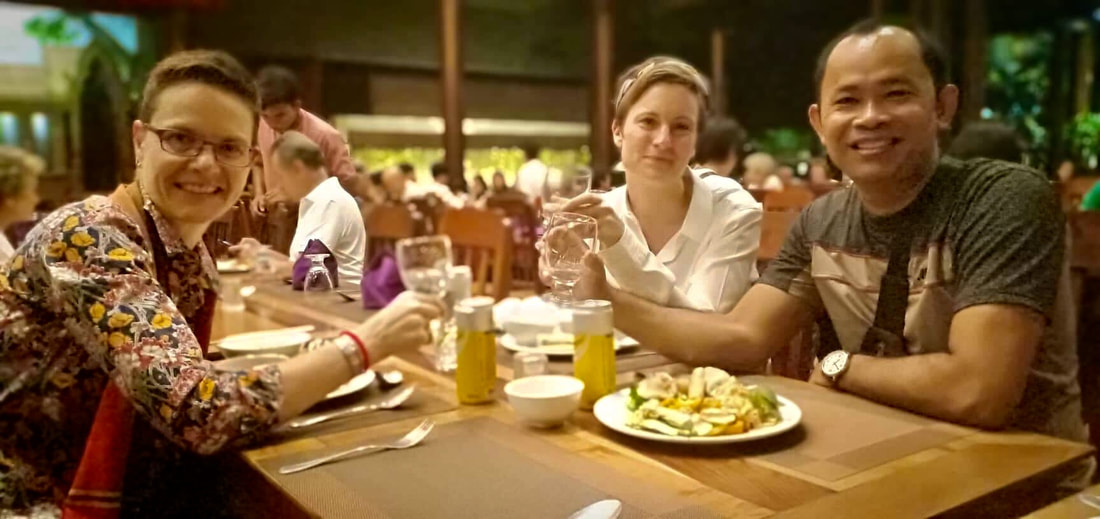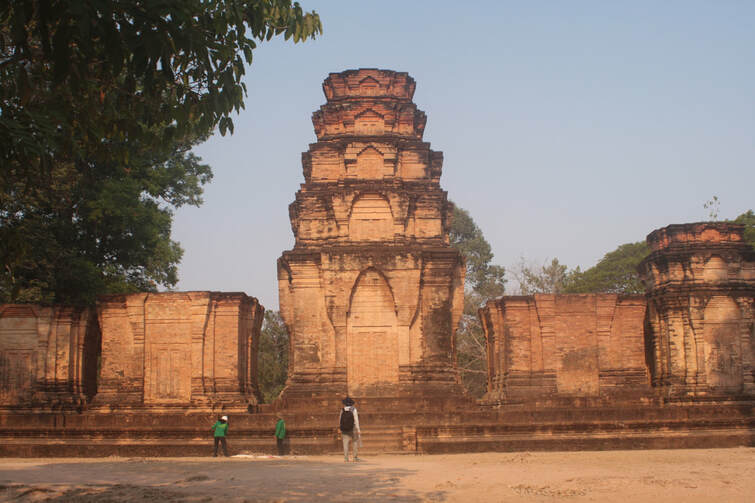Tales of Pacific Pride
|
‘Your driver is here,’ says one of the hotel staff as Sarah enters the foyer on Wednesday night. ‘That’s not our driver,' says Sarah, 'that’s our friend.’
Naga Cambo, our tuk-tuk driver from three years ago, has arrived to take us to dinner. We greet each other with a sampeah. There are five levels of sampeah, all involving a bow: for friends - palms together at chest level; for older people or people of rank - palms together at the mouth level; for parents, grandparents or a teacher - palms together at the nose level; for the king or monks - palms together at the eyebrow level; and lastly praying to Buddha or sacred statues - palms together at the forehead. So it’s a nice surprise after the formality when Mr Naga follows up with a hug. It’s good to see him; it’s been two and a half years. May 2016: we arrive for ten days’ holiday in Siem Reap. Our first trip in 2009 gave us a taste for temples off the beaten track; they have few tourists and little, if any, restoration. Whilst you have to see Angkor Wat and the Bayon complex, these lesser-known temples are our favourites. We’ve scoured our Lonely Planet and have made a list. Through the Rambutan, we’ve arranged for a tuk-tuk to collect us and take us to our hotel. Whilst only 6km from the airport, as Deborah said to us recently, 6 kilometres can seem like 20, when your top speed is 38.5km/hr. It’s blisteringly hot and searingly dry; smoke hangs low in the air and the light is an eerie, dirty orange. Forest fires, Mr Naga tells us; people are burning the land to clear it. It’s only mid-morning, but whilst we’re feeling quite refreshed having overnighted in Bangkok, we’ve not really put a plan together. We have a list of about forty temples and a vague idea of half a day of temples, half a day by the salt pool, cooling cocktail in hand. So, even though we’re not that keen to revisit temples we’ve seen, that afternoon Mr Naga takes us back to Ta Prom (made famous by Angelina Jolie in Tombraider). The last time we were here, it was midday, stinking hot, crawling with tourists, and being renovated: the sound of chainsaws was deafening. This time, it’s much more tranquil. We're also on the hunt for the stegosaurus carving. No one knows why or how amongst elephants, turtles, apsaras and deities, there is a single stegosaurus carving (and plenty of people say it’s not a stegosaurus at all - but we reckon it is). From that first stop, ten days of really getting to know the temples, and Mr Naga, begin. We discover Naga also does moto tours when he only has a single patron, and he’s actually taken some quite intrepid travellers to some very remote temples. On the second day, he looks at our list and tells us he’ll take us somewhere more interesting. At first we’re sceptical - we’ve done our research - but after a particularly obscure detour he pulls up at the foot of a towering mound of ancient collapsed brickwork. This is Chau Srei Vibol, and we’re the only visitors. There’s an elderly man who speaks no English roaming the site; he leads us around the leaning pillars and lichen-covered stones held up by strangler figs. This is the kind of experience we’re still a little nervous about, but we get used to it as the trip unfolds. Naga usually lets us know in advance if there’s a self-appointed local guide. Some of these temples are remote, and in a country with limited social security, a dollar from a tourist can make a real difference to someone elderly or disabled whose work options are limited. At Chau Srei Vibol, we quickly became very glad of him, the warnings not to stray off known paths due to landmines in the back of our minds. In the end, we saw 44 temples in 10 days. We climbed 635 steps to reach Phnom Bok, a mountain-top temple with killer views but whose real magic came from the ancient frangipani trees, sprouting gnarled and massive out of the two temple pillars. We trekked up the river bed at Kpal Spean, River of a Thousand Linga (sacred penises), sharing our stash of rambutans with Mr Naga’s friend the policeman who guarded the site. When we told him how much they cost per kilo in Australia, he had hysterics. And we fell utterly in love with Beng Melea, a massive complex which combines the scale of some of the Angkorian temples with the lichen-and-fig wilderness of Ta Prom. We saw more yoni and linga than we could count, stone representations of sacred genitalia, the lips and mouth of the yoni always pointing North, although nothing could top the massive two metre yoni-linga carved out of bedrock on the ring-road out to Koh Ker. It's late afternoon and we're coming to the end of time here; we've just about exhausted our list of temples. As we clamber into the tuk-tuk, Naga turns and asks, 'One more temple? It's on the way back'. Prasat Kravan is a small 10th-century temple consisting of five reddish brick towers. We've driven past it numerous times, both this trip and the last. It wasn't on our list and doesn't look too remarkable from the roadside. At about 5pm, the sky is turning dusky pink; a combination of the sun's weakening rays and smoke from the forest fires which are still burning. The light reflects off Kravan's façade, dramatically enhancing the hues of the red brick. It looks spectacular at sunset. Sensing we're not quite in love yet, Naga advises that we need to go around the back. The temple is dedicated to Vishnu, and the interior of each of the five towers shows large bas-relief images of the god and his consort Lakshmi, the Hindu goddess of wealth, prosperity and fortune. The carvings are exquisite, some of the best preserved we have seen, as is the Sanskrit which is carved into the posts at the entrance to each tower. Amid the bustle of the Angkor complex, Kravan keeps her quiet secrets, but not from Naga, and no longer from us. He's brought us to his favourite temples, Kravan included, as well as a butterfly farm, to various craftspeople, into the market where he bought his own wedding clothes, as well as countless good places to eat. He's helped us buy forest fruits by the roadside, as well as stuffed frog, and convinced us to try prahok, a fermented fish paste. At this point in his life, Naga hasn't yet become a tour guide - that's still to come - but he's shown us ten days of wonders. If we can help our travellers see even a little bit of the Cambodia he's revealed to us, then everyone will leave this place at least a little bit in love. Naga Cambo: limyiv @ yahoo.com (+855) 92 402 400
0 Comments
Leave a Reply. |
Mel & Sarah
Currently blogging from home, in iso like everyone else, and catching up with PPC19 in the form of a daily photojournal. Archives
June 2020
Categories
|
Proudly powered by Weebly


 RSS Feed
RSS Feed